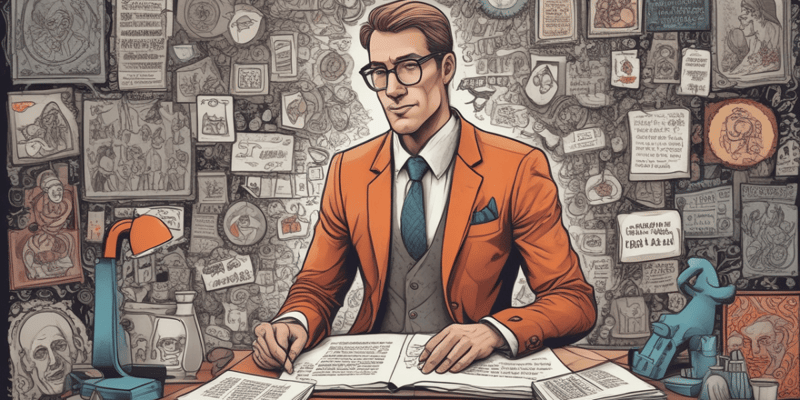Podcast
Questions and Answers
What is the primary goal of creating archetypes in innovation?
What is the primary goal of creating archetypes in innovation?
What is the main difference between archetypes and personas?
What is the main difference between archetypes and personas?
What do Proud Planners love to do?
What do Proud Planners love to do?
What do Wistful Worriers often do before leaving for a trip?
What do Wistful Worriers often do before leaving for a trip?
Signup and view all the answers
What do Dauntless Delegators hate to do?
What do Dauntless Delegators hate to do?
Signup and view all the answers
What can development teams use archetypes to do?
What can development teams use archetypes to do?
Signup and view all the answers
Why are archetypes useful in innovation?
Why are archetypes useful in innovation?
Signup and view all the answers
What is the purpose of identifying archetypes in innovation?
What is the purpose of identifying archetypes in innovation?
Signup and view all the answers
What do Wistful Worriers love to do after their trip?
What do Wistful Worriers love to do after their trip?
Signup and view all the answers
How can development teams use archetypes?
How can development teams use archetypes?
Signup and view all the answers
What is the primary goal of Step 1 in creating customer archetypes?
What is the primary goal of Step 1 in creating customer archetypes?
Signup and view all the answers
What is the purpose of refining patterns and themes in Step 2?
What is the purpose of refining patterns and themes in Step 2?
Signup and view all the answers
What is the purpose of creating customer archetypes?
What is the purpose of creating customer archetypes?
Signup and view all the answers
What is the outcome of shadowing and interviewing business and leisure travelers?
What is the outcome of shadowing and interviewing business and leisure travelers?
Signup and view all the answers
Why is it important to capture blind spots in customer research?
Why is it important to capture blind spots in customer research?
Signup and view all the answers
What is the outcome of Step 1 in creating customer archetypes?
What is the outcome of Step 1 in creating customer archetypes?
Signup and view all the answers
What is the purpose of calling out instances of signs of gold visually?
What is the purpose of calling out instances of signs of gold visually?
Signup and view all the answers
What is the outcome of refining patterns and themes in Step 2?
What is the outcome of refining patterns and themes in Step 2?
Signup and view all the answers
Study Notes
Identifying Insights for Product Design
- Hone in on what isn't effortless and delightful for travelers today to inform product design and development.
- Archetypes are ageless, genderless representations of "types" of people, amplifying specific behavioral qualities.
Archetypes vs. Personas
- Archetypes represent a market segment and focus on habits people exhibit when performing tasks.
- Personas are fictionalized characters with demographic characteristics.
- Archetypes have a bias towards habits, whereas personas focus on demographics.
Examples of Archetypes
- Proud Planners: love planning and organizing their trip, even enjoying it more than the actual vacation.
- Wistful Worriers: embrace travel but get nervous, seeking advice from friends and colleagues, and often arrive flustered.
- Dauntless Delegators: hate planning details, enlist others to do the work, and enjoy an amazing experience while traveling.
Using Archetypes in Product Design
- Development teams can use archetypes to anchor their app design and user experience to delight targeted archetypes.
- Teams can design for all or some archetypes without disrupting the experience of others.
Creating Customer Archetypes
- Capture and cluster insights by reading through notes, identifying meaningful anecdotes, and recurring themes.
- Edit and refine patterns and themes, keeping the charter in mind and surfacing standout observations and patterns.
Synthesizing for Meaningful Insight
- Summarize findings to draw vital conclusions about who customers are.
- Identify direct quotes, recurring themes, blind spots, validation, and confirmation of previous hypotheses with evidence.
Studying That Suits You
Use AI to generate personalized quizzes and flashcards to suit your learning preferences.
Description
Innovation Customer Discovery Learn to transform customer research into meaningful insights by identifying and analyzing customer archetypes. Create deep customer profiles with anthropology-derived methods.



